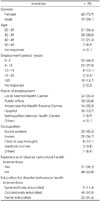Abstract
Objectives
This study was conducted to quantify the six dimensions of obstacles to disaster behavioral health (DBH), which was explored through the previous Qualitative Content Analysis of field workers' experiences after the Sewol Ferry accident and to determine the preference and significance of the details of every dimension.
Methods
Based on the six dimensions and their details, structured questionnaires were devised. The field workers as DBH service providers were requested to choose not only the most urgent item but also the reason for their choice. For the statistical analysis, the field workers were grouped by age, employment period, place of employment, occupation, mental health professional certificate, and experience and education of DBH interventions. Differences of the groups were analyzed using chi-square test.
Results
The questionnaires were distributed to 284 field workers for DBH, and a total of 79 usable questionnaires were collected and analyzed. Out of six dimensions, 43% of the field workers primarily suffered from difficulties in vertical relations of the administration system. Vague policy on DBH was the most challenging in difficulties in vertical relations of administration system (32.9%). The details of the other 5 dimensions were also discovered. Several significant differences were identified among groups according to the structured questionnaires.
Figures and Tables
References
1. Ha KM. A study on developing the alternatives for Korea's basic plan for national safety management - comparative perspective among the US, Japan's, and Korea's national response frameworks. Korean Comp Gov Rev. 2011; 15:209–232.
2. Choi NH. Establishing the public support system for disaster survivors. Korean Rev Crisis Emerg Manage. 2006; 2:1–18.
3. Lee EE. A study on the efficient disaster relief services in Korea. Korean Rev Crisis Emerg Manage. 2007; 3:69–81.
4. Zhang G, Pfefferbaum B, Narayanan P, Lee S, Thielman S, North CS. Psychiatric disorders after terrorist bombings among rescue workers and bombing survivors in Nairobi and rescue workers in Oklahoma City. Ann Clin Psychiatry. 2016; 28:22–30.
5. Boe HJ, Holgersen KH, Holen A. Mental health outcomes and predictors of chronic disorders after the North Sea oil rig disaster: 27-year longitudinal follow-up study. J Nerv Ment Dis. 2011; 199:49–54.

6. Jacobs GA. The development of a national plan for disaster mental health. Prof Psychol Res Pract. 1995; 26:543–549.

7. Dass-Brailsford P. Crisis and disaster counseling: lessons learned from hurricane katrina and other disasters. Thousand Oaks: SAGE Publications;2010.
8. Development the model and the operating system for national mental health trauma center (tentatively named). Prism.go.kr [homepage on the Internet]. Seoul: Korean Disaster and Trauma Mental Health Committee, Korean Mental Health Foundation;2014. updated 2014 Nov 21. cited 2016 Jan 28. Available from: http://www.prism.go.kr/homepage/researchCommon/retrieveResearchDetailPopup.do?research_id=1351000-201400174.
9. Ji JG, Hwang KR. A study on the post-traumatic stress disorder of the bereaved families of subway conflagration in Daegu. Korean J East West Mind Sci. 2008; 11:97–112.
10. Lee SH. Sewol ferry 100th day: Ansan trauma center has a long way forward. NEWSIS. 2014. 07. 23.
11. Lee YE. Sewol special committee "Why didn't government establish disaster behavioral health services system?". Inews24. 2014. 07. 04.
12. Paik JW, Kim HS, Sim M, Lee HK, Woo YS, Chung C, et al. The Sewol ferry accident and early mental health care response by volunteer activities of Korean disaster mental health committee and members of Korean neuropsychiatric association. J Korean Neuropsychiatr Assoc. 2015; 54:1–5.

13. Cohen RE. Mental health services for victims of disasters. World Psychiatry. 2002; 1:149–152.
14. Lee NB, Sim KS, Han SU, Lee KU, Sim MY, Chae JH, et al. A qualitative content analysis of reports of mental health service providers after the Sewol ferry accident in Korea. Ment Health Soc Work. 2015; 43:116–144.
15. Park JE, Woo JM. Mental health management system of community and government in disaster. Ment Health Policy Forum. 2011; 5:22–38.
16. Park MO. Disaster behavioral health services system need to introduce a psychiatric emergency interventions. Medical Today. 2014. 07. 30.
17. Kukinews. Problems of excessive complex reporting system when disaster occurs. Kukinews. 2014. 09. 18.
18. Han DS. It's time for government and society to smooth over the hurts between victims and survivors of disaster. Kihoilbo. 2015. 04. 23.
19. Seo MJ. A failure of disaster behavioral health service. Medical Observer. 2014. 07. 01.
20. Oh MA, Paik JW, Na KS, Kim NR, Chung C, Lee HK, et al. Review of disaster mental health system in Japan. J Korean Neuropsychiatr Assoc. 2015; 54:6–10.

21. Choi BK. Is Chung-buk safe? Total failure of disaster management system. Chungbukilbo. 2014. 04. 23.
22. Ministry of Health and Welfare, Bureau of Health Policy, Division of Mental Policy. 2015 mental health policy infomation. Seoul: Iemun Inc.;2015. p. 68–75.
23. Lee DH, Kim SK, Choi TS, Kim JH. A study on research trends on disaster mental health in Korea. J Rehabil Psychol. 2015; 22:41–58.
24. Jung HW. At the first anniversary of Sewol ferry accident, stand at the crossroad between the distrust and the low confidence of society. Hankooki. 2015. 04. 06.




 PDF
PDF ePub
ePub Citation
Citation Print
Print











 XML Download
XML Download